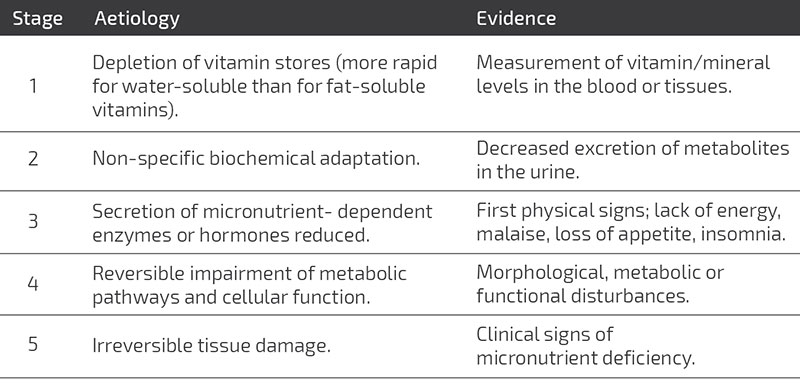Comprehensive Nutrient Test
*vitamins, minerals, and co-factors, amino acids and fatty acids (macronutrients)
- Identifies subtle deficiencies and borderline toxicities crucial to disease management and health optimization
- Provides actionable and targeted information to address marginal deficiencies and other imbalances
- Validated test methods and cutting-edge technology for cellular-level assessment of micro- and macronutrients
Marginal deficiencies may occur as a result of inadequate micronutrient intake, poor diet, malabsorption, and abnormal metabolism, coupled with the increased nutritional requirement of a demanding or stressful lifestyle, chronic conditions, and medications. Nutritional deficit impairs energy production of our cells, resulting to fatigue and predisposition to chronic and immune conditions.1
Clinical symptoms appear long after micronutrient deficiencies have developed, oftentimes in late stages where damage is almost irreversible.
The sub-clinical stages of marginal micronutrient deficiency:
Micronutrients Tested
Fat-Soluble Vitamins
Water-Soluble Vitamins
Minerals
Heavy Metals and Toxic Elements
Co-factors
- Amino Acids Panel
(Essential, Non-Essential and Metabolic) – Validated methods and studies showed that amino acid plasma analysis detects essential amino acid insufficiencies, thus providing a high level of reliability for indicating chronic stresses and evaluating several acquired conditions, like endocrine disorders, liver diseases, muscle diseases, neoplastic diseases, neurological disorders, nutritional disturbances, renal failure, and burns.
- Essential Fatty Acids
(Omega 3-6- 9 and Omega 6:3 ratio) – The Essential Fatty Acids Panel measures a wide array of omega acids in relation to the total fatty acids. The omega-3 to -6 ratio and arachidonic acid (AA) to eicosapentaenoic acid (EPA) are included as inflammatory markers and predictors of cardiovascular disease (CVD)2, where omega-3 fatty acid levels are suggested as a modifiable risk factor CVD prevention3. The analysis of fatty acids in red blood cells measures its 120-day lifespan in blood circulation, which reveals the metabolic functions and dietary intake factors on a longer time scale that can be used as a biomarker for fatty acid metabolism, diet-disease correlation, and epidemiological studies4,5.
Test Information
Specimen : 30 ml whole blood
Result TAT : 10 working days
Method : ICP-MS, LC-MS/MS, GC, HPLC-Fluorescence, Micro
2 Harris WS. The Omega-3 Index: Clinical Utility for Therapeutic Intervention. Curr Cardiol Rep. 2010;12:503-508
3 Simopoulos A. The importance of the ratio of omega 6/omega 3 essential fatty acids. Biomed Pharmacother. 2002;56:365-79.
4 Christie, W.W. Gas Chromatography and Lipids: A practical guide. Bridgwater,Somerset: The Oily Press Ltd, 1989
5 Rodrigues, R.O., Costa, H., Lima, R., & Amaral, J.S. “Simple Methodology for the Quantitative Analysis of Fatty Acids in Human Red Blood Cells.” Chromatographia 78, no. 19-20 (2015





